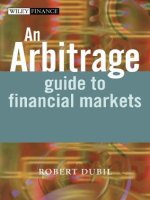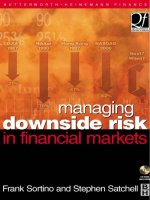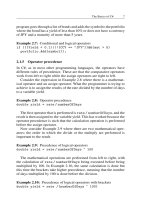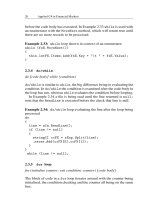forecasting financial markets 6e - plummer 2010
Bạn đang xem bản rút gọn của tài liệu. Xem và tải ngay bản đầy đủ của tài liệu tại đây (7.85 MB, 425 trang )
i
FORECASTING
FINANCIAL
MARKETS
ii
This page is intentionally left blank
iii
London and Philadelphia
FORECASTING
FINANCIAL
MARKETS
THE PSYCHOLOGY OF
SUCCESSFUL INVESTING
6th edition
TONY PLUMMER
iv
To Glenys
First published in 1989
Revised edition 1990
Second edition 1993
Third edition 1998
Fourth edition 2003
Fifth edition 2006
First published in paperback in 2008
Reprinted in 2009
Sixth edition 2010
Apart from any fair dealing for the purposes of research or private study, or criticism or review,
as permitted under the Copyright, Designs and Patents Act 1988, this publication may only be
reproduced, stored or transmitted, in any form or by any means, with the prior permission in
writing of the publishers, or in the case of reprographic reproduction, in accordance with the
terms and licences issued by the CLA. Enquiries concerning reproduction outside those terms
should be sent to the publishers at the undermentioned addresses:
120 Pentonville Road 525 South 4th Street, #241
London N1 9JN Philadelphia PA 19147
United Kingdom USA
www.koganpage.com
© Tony Plummer, 1989, 1993, 1998, 2003, 2006, 2010
The right of Tony Plummer to be identified as the author of this work has been asserted by him
in accordance with the Copyright, Designs and Patents Act 1988.
ISBN 978 0 7494 5637 5
British Library Cataloguing in Publication Data
A CIP record for this book is available from the British Library
Library of Congress Cataloging-in-Publication Data
Plummer, Tony.
Forecasting financial markets : the psychology of successful investing/
Tony Plummer. — 6th ed.
p. cm.
Includes index.
ISBN 978-0-7494-5637-5
1. Stock price forecasting. 2. Investment analysis. 3. Investments. I Title.
HG4637.P57 2010
332.63Ј2220112 dc22
2009025464
Typeset by Saxon Graphics Ltd, Derby
Printed and bound in India by Replika Press Pvt Ltd
v
Contents
Foreword xiii
Preface to the sixth edition xv
Acknowledgements xix
Introduction 1
Part One: The logic of non-rational behaviour in financial
markets
1 Wholly individual or indivisibly whole 9
Introduction 9; The relationships in nature 10; The break
with tradition 10; The conceptual revolution 11; The
problem of motivation 11; The dualistic nature of
motivation 12; Conclusion 13
2 Two’s a crowd 15
Introduction 15; The influence of groups 16; The insights
of Gustave Le Bon 16; The group’s ability to organize
itself 17; Mind as a dynamic principle 18; The group
mind 19; The triune human brain 20; The neocortex 21;
The amygdala 22; The response to a threat 22;
The ‘intelligence’ of crowd
23
3 The individual in the crowd 26
The integrative tendency
26; Identification 26; Beliefs 27;
Self-awareness and confirmity enforcement 27; The crowd
leader 28; The findings of Stanley Milgram 29; Altruism
and conflict 29; Splitting and projection 30; Conclusion 30
4 The systems approach to crowd behaviour 33
Introduction 33; Non-equilibrium conditions 34; Openness
to the environment: the exchange of energy 34; Openness
to the environment: the exchange of information 35; The
mechanism for transmitting information 35; Feedback
loops and the transformation of information 36;
Oscillating systems 37; The role of the crowd leader 37;
The interrelationship between a crowd and its
environment 38; Conclusion 39
5 Cycles in the crowd 41
Introduction 41; The life cycle
41; Co-evolution 43; Limit
cycles 44; Limit cycles through time 45; Limits cycles in
nature 46; Multiple limit cycles 47; Multiple cycles in two
dimensions 48; The impact of shocks 48; The profile of
shocks 49; Shocks in two dimensions 50; Some insights
into social change 50
6 Approaches to forecasting crowd behaviour 54
Introduction 54; Random or non-random 54; Price
movements in the Dow 55; Strange attractors 58;
Predictable price movements 60; Methods of predicting
price movements 60; Economic forecasting 61; Problems
with economic forecasting 61; Problems with conceptual
framework 62; The rational expectations hypothesis 63;
Bubbles and crashes 64; Non-linear mathematics 65; The
challenge to economic theory 65; Technical analysis 66;
The past and present as a guide to the future 67; The
rationale behind technical analysis 67
Part Two: The dynamics of the bull–bear cycle
7 The stock market crowd 73
Introduction 73; The individual investor 73; The dealing
strategy 74; The financial market crowd 74; The influence
of emotions 76; The herd instinct 76; The mechanism
of price fluctuations 77; The bull–bear life cycle in
emotions 78; The objectives of technical analysis 78; The
influence of price movements on crowd psychology 79;
The contest between the two crowds 79; The influence of
prices on behaviour 80; The shift from isolation to
belonging 80; The limit cycle between prices and
behaviour 81; Beliefs and leadership 82; Individuals as
crowd leaders 82; The conditions for effective
leadership 83; Investment advisers 83; Conclusion 84
vi Contents
8 The shape of the bull–bear cycle 87
Introduction 87; The limit cycle between prices and
sentiment 88; The bias in the limit cycle 89; The influence
of ‘external’ factors 90; The limit cycle between equity
markets and the economy 91; The influence of shocks 92;
Pro-trend shocks 93; Contra-trend shocks and energy
gaps 93; Shocks and the limit cycle 94; The return to the
limit cycle 95; Practical implications 97; The pattern of
adjustment after troughs 97; The reversal process 98; The
idealized three-stage reversal pattern 99; The influence of
fear 100; The bias in the bull–bear cycle 101; Asymmetric
investment attitudes 101; The price pulse 102; The time
hierarchy 103; Price–sentiment limit cycles 103; Limit
cycles and the transmission of shocks 103; The hierarchy
of fluctuations 104; Conclusion
104
9 Energy gaps and pro-tr
end shocks 108
Introduction 108; Energy gaps 110; Bridging energy
gaps 111; Bridging the first energy gaps in financial
markets 112; Bridging the second energy gap in financial
markets 113; The importance of timing 115; Pro-trend
shocks in financial markets 116; Energy gaps and
information flows 118; Changes in the quality of
information 119; Identifying the shock point 120;
The pattern of a trend 120; Conclusion 121
10 The spiral and the golden ratio 124
Introduction 124; The mathematics of the spiral 124; The
Fibonacci number sequence 125; Fibonacci’s rabbit
problem 126; The Fibonacci sequence and nature 126;
The properties of the Fibonacci sequence 127; The
important ratios 128; The golden ratio 128; The golden
ratio in geometry 128; The golden mearure and the human
body 129; The golden measure in nature 130; Three terms
from two 130; The golden rectangle and the golden
ratio 131; The spiral of rectangles 132; The golden
spiral 132; Properties of the golden spiral 133; The golden
measure and ancient religious insight 134; The ‘laws’ of
life 135; Information and the human mind 135;
Recognizing information 136; Understanding by
analogy 136; Creative insight 137; Self-organizing
hierarchies 137; Metaphor and reality 138; Financial
market crowds 139; The golden measure and financial
markets 140
Contents vii
11 The mathematical basis of price movements 142
Introduction 142; The calculation of price targets 143; The
application of the target formula 144; Examples from the
UK gilt-edged market 146; additional examples 148;
Examples from the US Treasury bond market 151;
Conclusion 153
12 The shape of things to come 155
Introduction 155; Examples 155; Price and momentum 158;
Momentum examples 159; Imitations of cyclicality 160;
Stylized patterns 162; Asymmetry 162; Conclusion 163
Part Three: Forecasting turning points
13 The phenomenon of cycles 167
Introduction 167; The influence of groups 168;
Satiation 169; Transformation of energy and
information 169; The patterns that connects 170; Tracking
the cycle 171; Momentum indices 171; Momentum and the
cycle 172; Anticipating inflexion points 173; Velocity and
non-confirmation 174; Acceleration and the cycle 175;
Conclusion 176
14 The threefold nature of cycles 178
Introduction 178; The 11½ -year cycle in the Dow 178;
Idealized cycles 181; Comparing the cycles 182; The
11½ -year cycle and the panic of 2008 186; Actual cycle
timings 188; The four-year cycle in the Dow 189; Triads,
dyads and energy gaps 189; The 1987 Crash 190;
Confirming the energy gap 193; The Wall Street
Crash 193; Cycle characteristics 194; Cycle functions 195;
Cycle translation 196; Translations within a triad 196; The
influence of higher-level cycles 197; Cycle biases and
energy gaps 198; Cycle behavioural traits 199;
Behavioural traits in a base cycle 199; Behavioural traits
in a trend cycle 200; Behavioural traits in a terminal
cycle 200; A schematic for financial markets 201; Limited
cycle patterns 202; Conclusion 202
15 Economic cycles 205
Introduction 205; Note on economic theory 206; An
integrative view 207;
Relationships between economic
cycles 208; From Kitchin to Strauss and Howe 208; From
viii Foreword
Strauss and Howe to Kitchin 208; Kuznets and
Kondratyev 209; Economic theory and technical analysis
210; Cycle characteristics 211; Biases in cycles 211; An
example from history 213; Juglar cycles during the 1946
to 1980 Berry cycle 213; Theory and fact 214; The first
cycle 215; The second cycle 215; The third cycle 216;
Evolution 217; Labelling the cycles 218; Conclusion 219
16 Recurrence in economic and financial activity
221
Introduction 221; Economic and financial market
cycles 221; Searching for cycles 222; The 1866–94
cycle 223; The 1894–1921 cycle 224; The 1921–46
cycle 225; Strauss and Howe meta-cycle 226; The Berry
terminal cycle 227; The first Juglar cycle 228; The second
Juglar cycle 228; The third Juglar cycle 229; Confirming
the 1946 low 229; The 1946–80 Berry adaptation
cycle 230; The 1970–80 Juglar cycle 231; The Kitchin
triad 231; The post-1980 Berry regeneration cycle 233;
The Juglar transition and innovation cycles 234; Kitchin
cycles in the Juglar innovation cycle 235; The Juglar
disruption cycle 235; Kitchin cycles in the Juglar
disruption cycle 237; Conclusion 238
17 Integrating the cycles 240
Introduction 240; Historical schematic 240; Historical
experience 242; Survey of the schematic diagram 243; The
differing nature of upswings and downswings 245; Using
the schematic diagram 246; Disruption vs depression 247;
The next Berry crisis cycle 248; Kondratyev cycles 248;
The post-1949 Kondratyev cycle 251; Price cycles and
output cycles 253; Kondratyev, Berry, and Strauss and
Howe 254; Juglar disruption and Berry crisis 255;
Conclusion 257
18 Forecasting with cycles 259
Introduction 259; The post-1980 Berry cycle 259; Cycle
alignment 260; Sentiment in a Juglar innovation cycle
261; Sentiment in the Juglar disruption cycle 262;
Comparisons with previous terminal cycles 263;
Comparisons with averages of previous cycles 265;
Financial markets and the economy 266; Conclusion 268
Contents ix
19 Price patterns in financial markets 269
Introduction 269; Hierarchical trends 269; Markets and
fundamental trends 270; Economic cycles, price patterns
and price trends 271; The pattern of a trend 271; The
five–three wave pattern in complex structures 272; The
Elliott wave principle 273; Investment guidelines 274;
The buy signal after a low 274; Warning of a bear
phase 275; The terminal cycle 276; The location of
corrections 277; The strength of a contra-trend rallies 279;
Non-confirmation revisited 279; Anticipating turning
points 281; The golden ratio formulae 281; Some
examples 282; Conclusion 284
20 The Elliott wave principle 285
Elliott’s discovery 285; The price pulse as the basis of the
wave principle 286; The basic wave pattern 286;
Corrections 287; A universal phenomenon 287; The wave
principle as a natural phenomenon 288; Derived rules:
trend indications 288; Derived rules: impulse waves 289;
Derived rules: corrections 289; Complications within the
system 289; Fifth-wave variations: failures and extension
290; Behaviour following failure or extension 290; Fifth-
wave variations: diagonal triangles 292; Variations in
corrections: the three-phase A-wave 292; The flat
correction 293; Complex corrections 294; Triangles 295;
The implications of a triangle 295; Inverted corrections
297; The ‘rule of alternation’ 297; The problem with the
Elliott wave principle 298
21 Information shocks and corrections 301
Introduction 301; Information shocks 301; Information
shocks and a five-wave trend 302; Shocks and cycles 302;
Information shocks and boundaries 305; Corrections and
shocks 306; The golden ratio boundaries 308; Technical
corrections and fundamental reversals 308; Top
retractments 309; Base retractments 311; Corrections
and trend reversals 312; The 1987 Crash and the 2000–02
bear 312; Hierarchical structuring 313; Guidelines for
calculating boundaries 315; Pro-trend shocks 316; A
practical example 318; The base pattern 318; The wave 4
correction 319; The dollar–yen bear market 320;
Conclusion
321
x Contents
22 The confirmation of buy and sell signals 323
Introduction 323; Investor confidence and price
flucuations 324; Overextended markets and the principle
of non-confirmation 324; Indicators of investor behaviour
325; Volume and open interest 326; The level of volume
327; The level of open interest 327; Sudden changes in
indicators 328; The direction and change in volume and
open interest 328; Changing emotions during the cycle
328; Sharp rises in volume and open interest 329; The
reversal process 329; Volume and open interest during
fifth waves 329; Volume and open interest during re-tests
330; The wider implications of falling open interest 331;
Momentum and overextended markets 333; Momentum
and non-confirmation 333; Measures of momentum 333;
Rates of change 334; Deviations from a moving average
335; The relative strength index (RSI) 336; Momentum
trading rules 337; The directional indicator 337; The
advance–decline index 338; A second price index 339; The
principle of direct confirmation: the Dow theory 339; The
principle of direct confirmation: other indicies 343;
Conclusion 343
Part Four: The psychology of trading
23 The psychology of fear 349
Introduction 349; The subconscious mind 350; The role of
habits 351; The response to a threat 352; Stress 354; The
influence of emotions 355; Beliefs and memories 356;
Conclusion 358
24 The troubled trader 361
Introduction 361; The three-part mind 362; The
psychological matrix 362; Basic personality types 363;
Primary behavioural characteristics 364; The gut-oriented
personality 365; The heart-oriented personality 366; The
head-oriented personality 366; The chink in the ego’s
armour 367; Basic motivations 367; Avoidance
compulsions 368; Response strategies 369; Some
awkward personal questions 370; The threat from financial
markets 371; Financial markets and personal space 372;
Financial markets and the self-image 372; Financial
markets and fear 373; The emergence of the crowd 374;
Conclusion
374
Contents xi
25 The psychology of success 377
Introduction 377; Basic requirements 377; Goal-
setting 378; Goals for the trader 379; Practical
considerations 380; The five aspects of effective goal-
setting 381; Converting desires into actual beliefs 383;
Visualization 383; Writing down and affirmations 384;
Strategy for achieving goals 385; Strategies for traders
386; Method 386; Energy 387; Physical health 387;
Mental and emotional health 388; Stress 389; Relaxation
techniques 390; Conclusion 391
26 Summary and conclusions 393
Index
397
xii Contents
xiii
Foreword
The last four decades have witnessed dramatic changes in the
behaviour of the free world’s financial markets. The fundamental
causes of these changes must embrace both the end of fixed exchange
rates in the early 1970s and the progressive removal of controls on
international financial flows. However, whatever the precise reasons
may be, the symptoms are evident:
ᔡ
a very marked increase in the volatility of prices and volumes in
most markets;
ᔡ
sharp and growing clashes between short-term developments and
long-term trends;
ᔡ
striking contradictions between market sentiment and economic
fundamentals.
The practical consequences have sometimes daunting and sometimes
humiliating challenges for forecasters but, far more importantly,
much greater risk and uncertainty for businesspeople and traders.
Despite the vast flow of data and major advances in computing and
applied statistics, conventional forecasting and economic analysis
are all too often not providing the guidance market operators need.
So, it is clear that we should now ponder on why this is and consider,
in an open-minded way, what can be done to broaden and strengthen
the techniques we rely on. We need to widen our horizons so as to be
able to heed the methods and results of technical analysis. The
minimum argument for doing so is the cynical or expedient one that
many professionals in the financial markets draw heavily on tech-
nical analysis in one way or another in their dealing as well as their
writing and advising. A stronger argument is that technical analysis
involves a serious attempt to reflect phenomena such as peer-group
pressure, fashion, crowd psychology and much else, which are
ignored or assumed unreliable by conventional theory. Regrettably,
there has been little common ground sought between conventional
forecasters and technical analysts. Tony Plummer’s book is, in part, a
contribution to that debate. However, it is also a serious attempt to
state systematically the basis of technical analysis in a way that
should interest not only other practitioners and sceptical economists,
but also countless thoughtful managers who are rightly impatient
with expert ‘forecasts’, which are, alas, not always worth the paper
they are printed on.
Sir Adam Ridley
Director General, London Investment Banking Association
Special Adviser to successive Chancellors of the Exchequer 1979–85
xiv Foreword
xv
Preface to the sixth
edition
We learn from our mistakes, and we interpret the world in the light
of our own experiences. Forecasting Financial Markets is a result of
both these truths. In 1979, I was forced to learn that the economic
theory that I had learnt at the University of Kent and the London
School of Economics did not always work in the real world. At the
time, I was trading in the gilt-edged market in London. Prime
Minister James Callaghan had been overseeing a major inflationary
episode, fuelled by rising government spending and accelerating
monetary growth. Basic economics taught me that the UK needed a
significant tightening of monetary policy and that bond prices were
in a serious bear market. However, in early 1979, gilt-edged stock
prices rallied by about 20 per cent in the space of a few weeks,
thereby retracing a good two-thirds of the previous year’s fall. The
rally was triggered by what was subsequently referred to as the
‘Battle of Watling Street’: representatives of City institutions
literally fought to get into the Bank of England’s debt issuing office
prior to a 10 am deadline, in order to cover massive short positions.
For a while, the civilized atmosphere of the City of London degen-
erated into the physical behaviour of a crowd. Many missed the
deadline: demand for bonds exceeded the supply of bonds, and
prices soared.
Extraordinarily, however, the rally was not just a normal, short-
lived bear squeeze. It extended over eight weeks. Day after day, prices
went up, almost without pause. It was as if ‘fundamentals’ didn’t
matter; all that mattered was that investors were short of stock. The
normally rational atmosphere of the London gilts market degenerated
into the psychological behaviour of the herd. When Mrs Thatcher
came to power in May 1979, monetary policy was tightened and gilt
prices spent almost a year losing the gains of February to May.
Rational economics finally won the day, but a lot of investors lost a lot
of money in the meantime.
This experience was a big lesson for me. The recognition that
people do not always act rationally, and do not always make decisions
independently of one another, necessitated a shift in the way I
approached financial markets. However, it was quite clear that there
was no central body of literature to which I could turn. So, within a few
weeks, I began my own process of collecting ideas and related infor-
mation, and in 1989 – 10 years after ‘Watling Street’ – the resulting
understandings found expression in the first edition of this book. Since
then, there has been an explosion of literature from authors such as
Howard Bloom (The Lucifer Principle, Atlantic Monthly Press, 1995,
and Global Brain, John Wiley, 2000) that substantially validates my
conclusions about the pervasive influence of crowd psychology.
Economic man, who makes decisions on the basis of ‘rational expecta-
tions’, is not only a travesty of a human being, but an impossible
construct. For good and for ill, human beings are literally programmed
to coexist, cooperate and correlate with one another. Such relation-
ships validate us and stimulate our emotional life.
This, in itself, is very important for our understanding of financial
and economic behaviour. By definition, once people start to group
together, behaviour within the context of the group becomes non-
random. This is why – despite what some statisticians may say –
financial market price action has a non-random dimension. But this is
not all. Somewhat startlingly to someone who recognizes it for the first
time, market price action persistently expresses itself in a three-wave
pattern that mirrors the processes of learning, and of energy absorption,
in living organisms. The crowd, in other words, is not different to other
parts of Nature. As such, it is intrinsically predictable.
Forecasting Financial Markets has now come a long way since
those initial, exciting discoveries of the 1980s. For a start, my
research revealed that the archetypal three-wave pattern existed not
only in financial markets, but also in economic activity. Moreover, I
found that the nature of market oscillations pointed persistently to a
specific mathematical influence that allows us to identify the
xvi Preface to the sixth edition
difference between a technical reaction to an impulse wave and the
emergence of a new trend. A wonderful, organized and essentially
predictable world emerged from the apparent chaos. This sixth edition
continues the process of clarifying and expanding on these findings.
One of the results has been a reclassification of certain aspects of
cycles. I hope that this will be seen as part of the evolution of under-
standing. But the basic findings remain intact: collective human
behaviour is not random; it is instead both rhythmic and patterned.
Consequently, it is possible to compare cycle patterns, both over time
and between markets, and obtain an extraordinarily accurate
perspective on current events.
Preface to the sixth edition xvii
This page is intentionally left blank
xviii Forecasting financial markets
xix
Acknowledgements
Very few authors can have had their work published without the assis-
tance and encouragement of other people. This one is certainly no
exception.
My sincere thanks still go to Michael Hughes, who patiently read
the manuscript of the first edition and provided sound advice on how
to recreate it in a more acceptable form. Needless to say, any subse-
quent errors remain my own.
My thanks also to my former colleagues at Hambros Bank, espe-
cially David Tapper and John Heywood. Their support and advice
over the years were major influences on my interest in the workings of
financial markets; and some of David’s wisdom in particular has
found expression in the following pages, albeit in ways that he might
not immediately recognize!
I am very grateful to my wife and family. They accepted my
commitment and provided complete support for the task, even when I
persistently spent long evenings and weekends hunched over a word
processor.
Finally, my thanks must also go to my travelling companions on the
7.30 am from Audley End. It was their dedication to either sleep or
crossword puzzles that enabled the earliest version of the manuscript
to be written in the first place.
This page is intentionally left blank
xx
1
Introduction
Making money by trading in financial markets is a formidable task.
This is a great truth that is almost impossible for one person to teach to
another. It can only be realized by the very act of trading. Accordingly,
very few people enter the trading arena with their eyes fully open to
the psychological and financial risks. Indeed, they approach markets
in the same way that they might approach a lake containing a fabled
treasure. They feel that all they have to do is set up appropriate
pumping equipment and the treasure is theirs. What they do not realize
is that – as in all good fairy stories – the lake has magical properties,
designed to protect the integrity of the treasure. Most people who
touch the sparkling water of the lake are doomed to be transformed by
it: they become treasure protectors instead of treasure hunters.
The problem is that there is an energy in financial markets (and,
indeed, in economic activity) that somehow coerces and organizes
investors into a single-minded unit. There is nothing sinister in this: it
is just nature ‘doing its thing’. However, the force is a psychological
one, and it is so powerful that investors do not recognize it until they
are finally caught in a disastrous bear market that wipes out months, if
not years, of hard work.
The corollary of this is that truly great traders are very rare – only a
few have the special clothing that protects them from the secret effects
of the lake. Jack Schwager’s books on ‘Market Wizards’ would not
otherwise be best-sellers.
1
What is it, though, that separates such
traders from the rest of us? How can some traders make regular and
large profits, while others are unable to string two successive winning
trades together? The traditional answer is that the quality of the
trading system may not be good enough. Much time and money is
therefore spent on developing trading systems in order to generate
improved entry and exit signals. The problem, however, is that a good
trading system – while absolutely essential – is only part of the
solution. It is also necessary to be able to implement the signals on a
consistent basis.
This may seem like a trivial statement, but it is not.
2
The reality is
that successful trading requires a certain psychological competence to
do the job and, unfortunately, nature has chosen not to wire up the
human psyche with automatic access to this competence. The point
here is that financial markets can have a direct and dramatic effect on
wealth and on associated living standards. Most people are therefore
likely to experience an emotional response as the market adds to, or
subtracts from, the value of their assets. This is not necessarily bad in
itself, but it does mean that when a system generates a buy or sell
signal, the investor will still feel obliged to decide whether or not to
implement that signal. Investment thereby moves away from the
objective realm and into the subjective realm.
On this analysis, success or failure hinges critically on the ability to
penetrate the ‘emotional gateway’ between the generation of a ‘buy’
or ‘sell’ signal and the implementation of that signal. Penetrating this
gateway is, in essence, what this book is about. However, success is
not just a case of heavy armour and battering rams. Such methods can
work for short periods of time, but they require a heavy expenditure of
energy and, inevitably, exhaustion sets in. A much more rewarding
approach is to see the gateway as a learning opportunity. For the truth
is that, once the necessary learnings have been completed, the
gateway simply disappears.
Nor are the learnings particularly difficult. We are not talking about
a lifetime of struggle that then enables a magnificent and heroic
investment decision to be made from the deathbed. We are talking
about relatively small adjustments in understandings, attitudes and
responses, so that a large number of successful decisions can be made
on a continuous basis. In fact, it is not too idealistic to say that we are
talking about a commitment to the truth of the situation. Such a
commitment encourages flexibility, without which we cannot respond
effectively to unexpected information: that is, we cannot admit to our
mistakes, we cannot be free of other people’s opinions and we cannot
make appropriate decisions.
Ultimately, it doesn’t matter what economic theory predicts or what
you believe ought to happen or what other people believe will happen.
All that matters is that you have aligned yourself with the actual
market trend, and if this involves changing your investment position,
your belief system or even your drinking companions, then so be it.
2 Forecasting financial markets
The argument of this book, then, is that flexibility in the decision-
making process can be attained by generating three interrelated skills.
The first of these is an ability to understand the market in logical
terms. That is, an investor or trader should have a philosophical
approach to markets that incorporates a genuine understanding of the
forces at work. The point is that markets fluctuate – regularly and,
according to traditional theory, unpredictably. If an investor does not
clearly recognize this, then they will be unprepared for the reality – the
terror – of the situation.
The second skill, in a sense, follows from this. An investor needs to
be able to understand their own emotional response to market fluctua-
tions. This is a part of what Daniel Goleman calls ‘emotional intelli-
gence’.
3
If market participants understand their own vulnerability to
the influences of financial markets, and if they can recognize those
associated behaviours that are potentially self-defeating, then they can
do something about it. In particular, they can adopt responses that are
appropriate to market trends rather than responses that are hostile to
them. The alternative, quite simply, is to become a victim.
Finally, of course, an investor needs to be able to design an
investment process, or trading system, that generates objective ‘buy’
and ‘sell’ signals. In other words, the signals must be based on pre-
determined criteria. This approach has two advantages:
ᔡ
first, it focuses attention on critical factors that tend to recur
through time;
ᔡ
second, it helps to reduce the influence of any emotions that occur
at that point in time.
Such a system need not be mechanical: it can have a facility to incor-
porate signals that cope with unusual circumstances or with investor
preferences. The only criterion that ultimately matters is that the
investor/trader is sufficiently confident about the signals that they will
not continuously be doubted. Market participants should, therefore, be
directly involved in the system testing procedures, so that they are
aware of both the successes and the limitations. This, of course, also
facilitates a creative response to unexpected market developments.
These three skills – the ability to understand market behaviour in
logical terms, the ability to know the effects of the market in
emotional terms and the ability to decide what to do in objective terms
– are the basis of successful wealth creation in financial markets.
Further, they enable investors and traders to be detached from the
results of each individual investment position in a way that enables
Introduction 3
them, literally, to enjoy the whole process. In this way, wealth creation
and personal fulfilment become a way of life.
In my opinion the first important step is to understand the
phenomenon of the ‘crowd’. Crowds come into being because of the
existence of common beliefs and because of the need for protection
from opposing beliefs. It is the dynamics of the crowd that cause
markets to fluctuate as they do. Over the course of a pronounced
market trend, investors become increasingly unable to penetrate the
emotional gateway that we described above. Instead, they tend to do
the same things at the same time in order to obtain psychological
support. Eventually, a significant price reversal occurs simply
because the majority are effectively ‘one-way’. By definition,
therefore, most investors will be on the wrong foot when a reversal
occurs. It is this fact, more than anything else, that explains traumas
such as the stock market crash of 1987, the bond market crash of
1994 and the financial panic of 2008. Once prices start to accelerate
in the opposite direction, investors and short-term traders are induced
to close off old positions and open new ones. Such behaviour maxi-
mizes losses and minimizes profits. The result is that very few
investors make consistently high returns over and above bank deposit
rates or outperform their benchmark indices.
The idea that people have a tendency to herd together is, of course,
not a new one. What is not yet clearly understood, however, is that
group, or crowd, behaviour is an unavoidable feature of the human
condition. The crowd is a potent force because it encourages indi-
viduals to subsume their own needs to those of others. This trans-
ference of responsibility introduces a very large non-rational, and
emotional, element to behaviour. Of course, very few people actually
recognize the influence of the crowd because, as the saying goes, ‘fish
don’t know that they’re swimming in water’. However, the baleful
influence of the crowd permeates all economic and financial
behaviour, and is particularly noticeable in financial markets.
This means that it takes only a small adjustment in our assumptions
concerning the nature of human motivation to generate a huge leap in our
understanding of observed human behaviour. Specifically, if we accept
the assumption that individual behaviour is influenced to some degree by
the need to associate with – and obtain the approval of – other people,
then all economic and financial behaviour can be seen as being ordered
rather than chaotic. The uncertain behaviour of the individual transmutes
into the more certain behaviour of the crowd. As a result, economic and
financial activity become more explicable and predictable.
4 Forecasting financial markets









